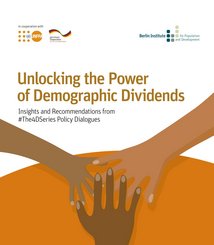
This report highlights the potential of targeted population policies to achieve demographic dividends.
Read more
Europe looks back on a turbulent decade in which financial, economic and debt crises led to mass unemployment and brought entire states to the brink of insolvency. As hundreds of thousands of refugees made their way to Europe, many people showed great willingness to help them. But at the same time, mass migration has caused new tension. These events have had a major impact on population development. New migration patterns have emerged while old ones have changed and in many places, fewer people want to start families in the face of economic insecurity. So where do Europe’s regions stand today and what are their long-term prospects? The Berlin Institute for Population and Development examines these questions using a large number of demographic and socio-economic indicators.
The Berlin Institute would like to thank the Nuremberg Institute for Market Decisions (formerly GfK Verein) for supporting this research project.
General inquiries
Telefon: +49 30 - 22 32 48 45
Contact via Mail: info@berlin-institut.org
© Berlin-Institut
Demographic change is not a disaster, but a challenge. Analyses and concepts are needed to master them successfully. The Berlin Institute for Population and Development provides these free of charge and makes a significant contribution to ensuring that important future issues are discussed on a broad basis and put on the political agenda. The non-profit Berlin Institute works on a non-partisan basis and receives no state funding whatsoever. Your donation therefore helps to maintain our independence and the high standard of our publications. Donations to the Berlin Institute are tax-deductible and can be made directly online using the donation button or by using a bank transfer form to the following account
Donation account
GLS Bank
IBAN DE15 4306 0967 1276 4833 00
BIC/SWIFT GENODEM1GLS
We thank you very much for your support!